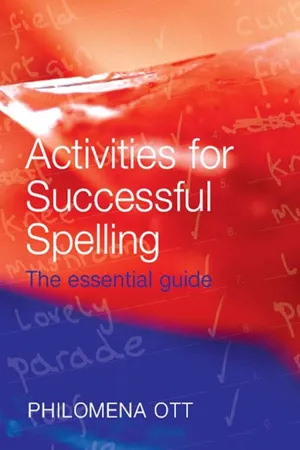
- 416 pages
- English
- ePUB (mobile friendly)
- Available on iOS & Android
About This Book
This highly practical activity workbook is linked to the core text How to Manage Spelling Successfully and has been designed to support dyslexic students practise the spelling strategies and methods recommended in that book.
This activity book can be used separately, or as part of an integrated programme for building students' spelling skills at home or at school. Suitable for mainstream classrooms, pupils undertaking additional literacy support in small groups, and for one-to-one teaching of individuals with specific learning difficulties including dyslexia, this excellent resource contains activities suitable for use at different stages of development, and for use with adults as well as school students.
Each section contains a range of multi-sensory activities, including word searches, simple crossword puzzles and dictation exercises. This is an essential classroom companion for anyone helping struggling spellers.
Frequently asked questions
Information
| /b/ | bus | /n/ | nut |
| /d/ | dog | /p/ | pot |
| /f/ | fan, photo | /r/ | rat |
| /g/ | gun | /s/ | sun, city |
| /h/ | hat | /t/ | tin |
| /j/ | jam, gym | /v/ | van |
| /k/ | cat, kid, choir | /w/ | wig |
| /l/ | log | /y/ | yak |
| /m/ | man | /z/ | zip |

| /sh/ | ship | /ph/ | phone |
| /ch/ | chin | /wh/ | whip |
| /th/ | that (voiced) | /gh/ | laugh |
| /th/ | thumb (unvoiced) |
| /ar/ | car |
| /er/,/ir/ | herb, skirt |
| /or/ | corn |
| /ur/ | nurse |

Table of contents
- Cover
- Title Page
- Dedication and Copyright page
- Contents
- Acknowledgements
- Introduction
- 1. How to manage synthetic phonics plainly and simply
- 2. How to manage syllables successfully
- 3. How to manage plurals painlessly
- 4. How to manage homophones happily
- 5. How to manage root words, prefixes and suffixes skilfully